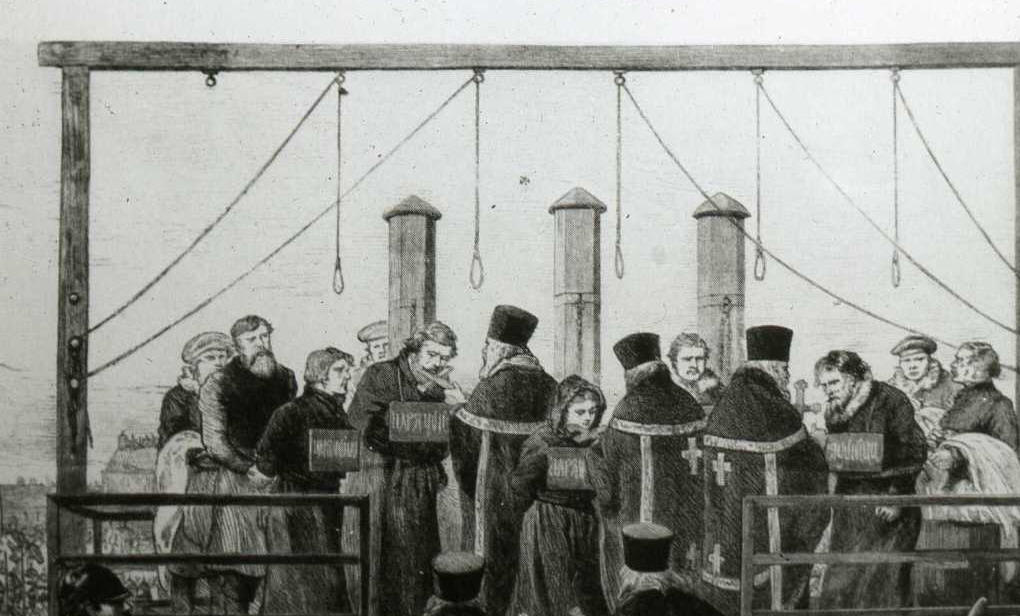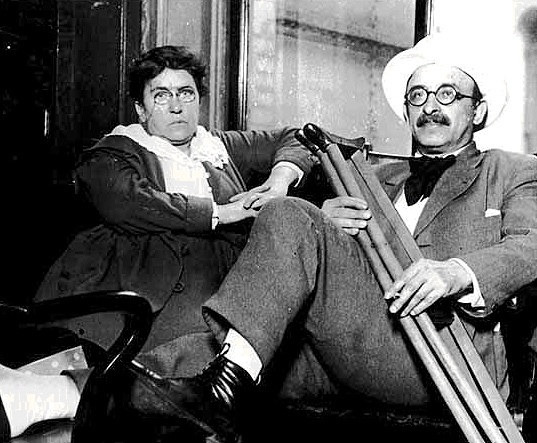…Though there was an attempt to kill the czar as early as 1866, the first generation of Russian terrorists generally confined their activities to executing traitors or police spies in their own ranks and to reprisals for the tortures, floggings, and hangings of an increasingly harsh repression. In 1879, however, a split in the revolutionary underground led to the formation of an extremist group called Narodnaia Volia, the Will of the People. Its program called for “terrorist activity to remove the most important personalities belonging to the Administration… This will have as a general aim the weakening and demoralization of the Administration…the strengthening of popular belief in the party’s ultimate success, and finally the inculcation of a fighting spirit.” The Will of the People thus became the first terrorist organization in the modern sense.

—Their dramatic gesture failed to ignite a social revolution or topple the autocracy, and they would find in Alexander III an implacable foe.
But while this spelled the end for the old man’s five assassins,‡ and even the end of Narodnaya Volya as an effective organization as the 1880′s unfolded, Alexander III’s efficacious repression was a Pyrrhic victory for the Romanov dynasty.
By depending on police operations rather than political reforms, Alexander III bequeathed his doomed successor a hopelessly backward political structure … and a considerably more dangerous revolutionary foe.—click image for source…
Dominated by two implacable personalities, Andrei Zhelyabov, the son of a serf, a bearded giant with hypnotic eyes, and Sophia Perovskaia, the daughter of a former high czarist official, a young girl with a pink-and-cream complexion, a childish face, and the reproving look of a governess, the Will of the People decided to strike the autocracy at its head.
After two unsuccessful attempts to assassinate Alexander II by blowing up his private train, the conspirators succeeded on February 5, 1880, in setting off a heavy charge of dynamite in the cellar of the Winter Palace, directly under the czar’s dining room, at exactly the hour he normally took his evening meal. Due to an unforeseen delay in his daily schedule, Alexander once more escaped death, but eleven members of the palace staff were killed and fifty-six wounded. The news of this unprecedented act created a sensation throughout Europe.

—Emma Goldman and Alexander Berkman, famous anarchists of the early 20th century, pictured here in New York a year after a 2 year stay in San Francisco.
Photo: Emma Goldman Papers Project
Emma Goldman and Alexander Berkman lived in the 500 block of Dolores Street while they published The Blast, a forthrightly subversive periodical ultimately shut down by the federal government. Goldman was deported to Russia in 1920. —click image for source…
A year later the terrorists finally killed Alexander with a bomb thrown at his carriage. Instead of shaking the Russian autocracy to its foundations, the assassination intensified reaction and repression- which, in turn, aggravated the revolutionary violence. The Will of the People was decimated by the arrest of the leading members. Five of them, including Zhelyabov and Sophia Perovskaia, were hanged. Their trial and execution etched in the Russian mind the romantic image of the revolutionary secret avenger- hero-martyr and self sacrificing assassin- that a Turgenev to Camus, has universalized and romanticized. ( to be continued)…
ADDENDUM:
(see link at end)… A precedent may be seen in the work of the French psychiatrist Frantz Fanon, who defended the use of violence against colonialism as an assertion of the identity of subjects of colonial power; but Fanon viewed this violence as part of a struggle for national independence, an objective that was in fact achieved.
A clearer precedent can be found in the work of the early-twentieth-century French theorist of syndicalism Georges Sorel. In Reflections on Violence (1908), Sorel argued that communism was a utopian myth—but a myth that had value in inspiring a morally regenerative revolt against the corruption of bourgeois society. The parallels between this view and Žižek’s account of “redemptive violence” inspired by the “communist hypothesis” are telling.
A celebration of violence is one of the most prominent strands in Žižek’s work. He finds fault with Marx for thinking that violence can be justified as part of the conflict between objectively defined social classes. Class war must not be understood as “a conflict between particular agents within social reality: it is not a difference between agents (which can be described by means of a detailed social analysis), but an antagonism (‘struggle’) which constitutes these agents.” Applying this view when discussing Stalin’s assault on the peasantry, Žižek describes how the distinction between kulaks (rich peasants) and others became “blurred and unworkable: in a situation of generalized poverty, clear criteria no longer applied, and the other two classes of peasants often joined the kulaks in their resistance to forced collectivization.” In response to this situation the Soviet authorities introduced a new category, the sub-kulak,
easant too poor to be classified as a kulak but who shared kulak values:
The art of identifying a kulak was thus no longer a matter of objective social analysis; it became a kind of complex “hermeneutics of suspicion,” of identifying an individual’s “true political attitudes” hidden beneath his or her deceptive public proclamations.
Describing mass murder in this way as an exercise in hermeneutics is repugnant and grotesque; it is also characteristic of Žižek’s work. He criticizes Stalin’s policy of collectivization, but not on account of the millions of human lives that were violently truncated or broken in its course. What Žižek criticizes is Stalin’s lingering attachment (however inconsistent or hypocritical) to “‘scientific’ Marxist terms.” Read More:http://www.nybooks.com/articles/archives/2012/jul/12/violent-visions-slavoj-zizek/?pagination=false








 COMMENTS
COMMENTS



